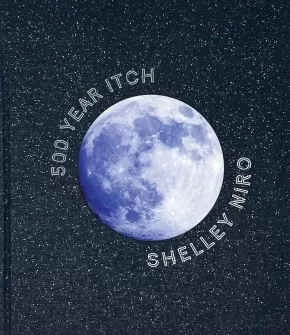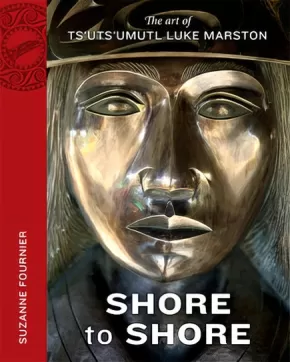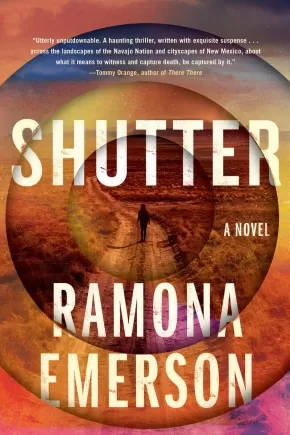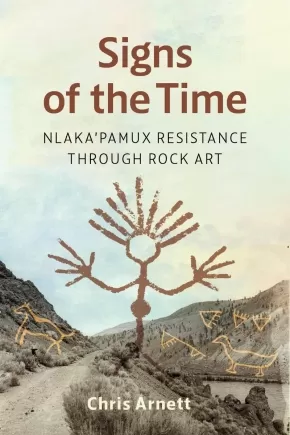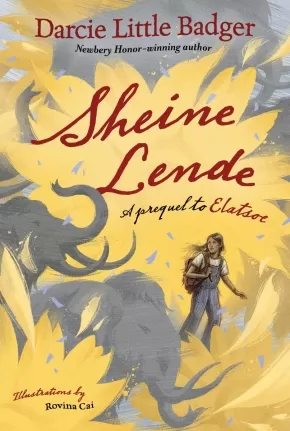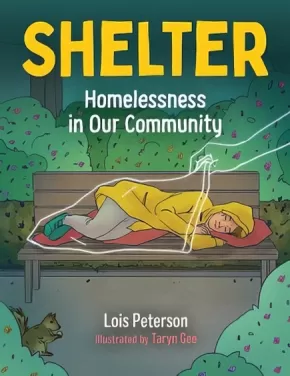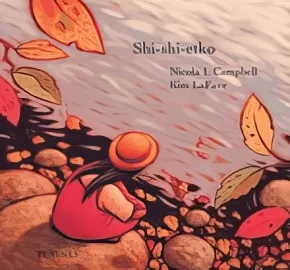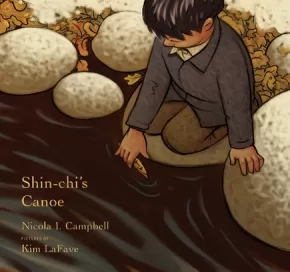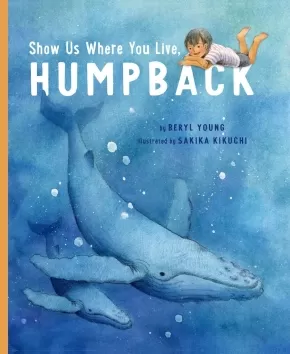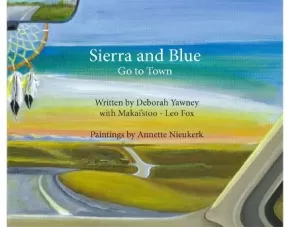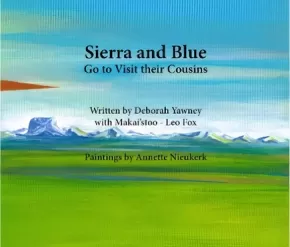
English
Books (4)
Shelley Niro: 500 Year Itch
$50.00
Format:
Hardcover
Text Content Territories:
Indigenous Canadian; First Nations; Haudenosaunee (Iroquois); Kanyen'keha:ka (Mohawk);
Reading Level: N/A
ISBN / Barcode: 9781897407356
Synopsis:
Synopsis:
Shelley Niro is widely known for her ability to explore Traditional Stories, transgress boundaries, and embody the ethos of her matriarchal culture. A member of the Kanyen’kehaka (Mohawk) Nation, she uses a wide variety of media, including photography, installation, film, and painting to bring greater visibility to Indigenous women and girls.
Pushing the limits of photography, Niro incorporates imagery from Traditional Stories to focus on contemporary subjects with wit, irony, and parody. Throughout her work — in her portraiture, sculptures, landscape paintings, photography, and film and video work — Niro challenges common preconceptions about gender, culture, and Indigenous Peoples.
Shelley Niro: 500 Year Itch brings together 215 reproductions from Niro’s expansive oeuvre, including work published here for the first time. Also included in this career retrospective are three major essays about Niro’s work by Melissa Bennett, Greg Hill, and David W. Penney, as well as texts from seven guest artists, scholars, and curators. Shelley Niro: 500 Year Itch accompanies an international touring exhibition organized by the Art Gallery of Hamilton and the Smithsonian National Museum of the American Indian with the collaboration of the National Gallery of Canada.
Additional Information
304 pages | 8.25" x 9.62"
Shore to Shore: The Art of Ts'uts'umutl Luke Marston
$26.95
Format:
Paperback
Text Content Territories:
Indigenous Canadian; First Nations; Salish; Coast Salish;
ISBN / Barcode: 9781550176704
Synopsis:
Synopsis:
Stanley Park, Vancouver, September 2014. A fourteen-foot bronze-cast cedar sculpture is being erected. Dignitaries from all levels of government are present, including leaders of the Coast Salish First Nations and representatives from Portugal's Azores Islands. Luke Marston, carver/artist, supervises as his three-year project is revealed to the world.
The sculpture--titled Shore to Shore--depicts Luke's great-great-grandparents, Portuguese Joe Silvey, one of BC's most colourful pioneers, and Kwatleematt (Lucy), a Sechelt First Nation matriarch and Silvey's second wife. Silvey and Kwatleematt are flanked by Khaltinaht, Silvey's first wife, a noblewoman from the Musqueam and Squamish First Nations. The trio are surrounded by the tools of Silvey's trade: seine nets, whaling harpoons, and the Pacific coast salmon that helped the family thrive in the early industries of BC. The sculpture references the multicultural relationships that are at the foundation of BC, while also showcasing the talents of one of Canada's finest contemporary First Nations carvers.
Combining interviews, research and creative non-fiction narration, author Suzanne Fournier recounts Marston's career, from his early beginnings carving totems for the public at the Royal BC Museum, to his study under Haida artist Robert Davidson and jewellery master Valentin Yotkov, to his visits to both his ancestral homes: Reid Island and the Portuguese Azores island of Pico--journeys which provided inspiration for the Shore to Shore statue.
Educator Information
Recommended in the Canadian Indigenous Books for Schools 2015/2016 resource list for grades 7 to 12 for comparative civilizations, English language arts, photography, social studies, and visual arts.
Additional Information
128 pages | 8.00" x 10.00"
Shutter
$34.95
Format:
Hardcover
Text Content Territories:
Indigenous American; Native American; Navajo (Diné);
Reading Level: N/A
ISBN / Barcode: 9781641293334
Synopsis:
Synopsis:
This blood-chilling debut set in New Mexico’s Navajo Nation is equal parts gripping crime thriller, supernatural horror, and poignant portrayal of coming of age on the reservation.
Rita Todacheene is a forensic photographer working for the Albuquerque police force. Her excellent photography skills have cracked many cases—she is almost supernaturally good at capturing details. In fact, Rita has been hiding a secret: she sees the ghosts of crime victims who point her toward the clues that other investigators overlook.
As a lone portal back to the living for traumatized spirits, Rita is terrorized by nagging ghosts who won’t let her sleep and who sabotage her personal life. Her taboo and psychologically harrowing ability was what drove her away from the Navajo reservation, where she was raised by her grandmother. It has isolated her from friends and gotten her in trouble with the law.
And now it might be what gets her killed.
When Rita is sent to photograph the scene of a supposed suicide on a highway overpass, the furious, discombobulated ghost of the victim—who insists she was murdered—latches onto Rita, forcing her on a quest for revenge against her killers, and Rita finds herself in the crosshairs of one of Albuquerque’s most dangerous cartels. Written in sparkling, gruesome prose, Shutter is an explosive debut from one of crime fiction's most powerful new voices.
Reviews
“Shutter is utterly unputdownable. It is a haunting thriller, written with exquisite suspense, and filled to the brim with beautiful writing, through the lens of cameras and memory—an ode to photography, written across the landscapes of the Navajo Nation and cityscapes of New Mexico, about what it means to witness and capture death, be captured by it, told unflinchingly by an author who knows what she is doing on every page. It is fun, and funny, and chilling. This is a story that won’t let you go long after you finish, and you won’t want it to end even as you can’t stop reading to find out how it does.”—Tommy Orange, author of There There
“Get ready for the next wave of Indigenous thrillers! Shutter is a soulful and mesmerizing exploration of the paranormal, set against the backdrop of New Mexico and the Navajo Nation. Written in tough, edgy prose, this book grabs you by the shoulders and refuses to let you leave. Ramona Emerson is a welcome new voice in Native literature.” —David Heska Wanbli Weiden, author of Winter Counts
“Beautiful, imaginative prose with a sharp edge. Shutter is a powerful and supernatural debut. I've never seen a better rendering of gifts and power. This work understands the spirit world and how it does not relent until we bear witness. Ramona Emerson is a badass, propulsive, exacting and true storyteller.”—Terese Mailhot, author of Heart Berries
“Emerson’s striking debut follows a Navajo police photographer almost literally to hell and back . . . A whodunit upstaged at every point by the unforgettably febrile intensity of the heroine’s first-person narrative.”—Kirkus Reviews
Educator & Series Information
This book is part of the A Rita Todacheene Novel series.
Additional Information
312 pages | 6.21" x 9.27" | Hardcover
Signs of the Time: Nlaka'pamux Resistance through Rock Art
$39.95
Format:
Paperback
Text Content Territories:
Indigenous Canadian; First Nations; Salish; Interior Salish; Nlaka'pamux (Thompson);
Reading Level: N/A
ISBN / Barcode: 9780774867962
Synopsis:
Synopsis:
Rock art – etched in blood-red lines into granite cliffs, boulders, and caves – appears as beguiling, graffiti-like abstraction. What are these signs? The petroglyphs and red-ochre pictographs found across Nlaka’pamux territory in present-day British Columbia and Washington State are far more than a collection of ancient motifs.
Signs of the Time explores the historical and cultural reasons for making rock art. Chris Arnett draws on extensive archival research and decades of work with Elders and other Nlaka’pamux community members, their oral histories and oral tradition, to document the variability and similarity of practices. Rock art was and is a form of communication between the spirit and physical worlds, a way to pass information to later generations, and a powerful protection against challenges to a people, land, and culture.
Nlaka’pamux have used such culturally prescribed means to forestall external threats to their lifeways from as early as the sixteenth century – when they were aware of incipient European encroachment – until well into the twentieth. As this important work attests, rock art remains a signature of resilience and resistance to colonization among Nlaka’pamux today.
As well as providing essential reading for scholars and students of archaeology, cultural and applied anthropology, Indigenous studies, and art history, Signs of the Time will also fascinate rock art specialists and amateur enthusiasts.
Reviews
"Signs of the Time is innovative and provocative, adding dramatically to the discussion of how Western science interacts with and accommodates Indigenous knowledge, concerns, and heritage." — David S. Whitley, author of Cave Paintings and the Human Spirit: The Origin of Creativity and Belief
"Signs of the Time is informative and accessible, giving equal voice to Indigenous knowledge keepers and academics in presenting the ideas in petroglyphs and pictographs. It is an excellent example of how Eurowestern academics can work alongside Indigenous knowledge experts to understand the Indigenous world. I highly recommend it." — Lorna Wanosts’a7 Williams EdD; OC; OBC; Lil’watul; professor emerita, University of Victoria
Additional Information
256 pages | 6.00" x 9.00" | 40 b&w photos
Teen Books (2)
Sheine Lende (HC) (7 in Stock)
$29.99
Format:
Hardcover
Text Content Territories:
Indigenous American; Native American; Apache; Lipan Apache Tribe of Texas;
ISBN / Barcode: 9781646143795
Synopsis:
Synopsis:
Shane works with her mother and their ghost dogs, tracking down missing persons even when their families can’t afford to pay. Their own family was displaced from their traditional home years ago following a devastating flood – and the loss of Shane’s father and her grandparents. They don’t think they’ll ever get their home back.
Then Shane’s mother and a local boy go missing, after a strange interaction with a fairy ring. Shane, her brother, her friends, and her lone, surviving grandparent – who isn’t to be trusted – set off on the road to find them. But they may not be anywhere in this world – or this place in time.
Nevertheless, Shane is going to find them.
Darcie Little Badger’s Elatsoe launched her career and in the years since has become a beloved favorite. This prequel to Elatsoe, centered on Ellie’s grandmother, deepens and expands Darcie’s one-of-a-kind world and introduces us to another cast of characters that will wend their way around readers’ hearts.
Educator & Series Information
Recommended for ages 12 to 18.
This book is part of the Elatsoe series.
Additional Information
400 pages | 5.50" x 8.25" | Hardcover
Shutout
$9.95
Format:
Paperback
ISBN / Barcode: 9781459818767
Synopsis:
Synopsis:
Alex Paterson is the number-one goalie on his high-school hockey team. And he's thrilled that his team has made the playoffs. But when graffiti that apparently can be traced back to Alex is found on the walls of the school, and a photo of Alex at a party with a beer in his hand starts making the rounds, he is suspended from the team, and his reputation as a good kid is put in doubt. Alex knows he's innocent. The problem is, he cannot figure out who would want to frame him. Or why. Is it the other goalie who wants all the glory for himself? Or someone from a rival team looking for an advantage? With everyone assuming the worst about him, it's up to Alex to find out who is behind it all, not only to clear his name, but to save the season.
Educator & Series Information
This book is part of the Orca Sports series. Orca Sports stories engage middle-schoolers and teens with fast-paced plots and easy-to-read language. Topics include a variety of team and individual sports. Reading levels from grade 2.0 to 4.5; Interest level ages 10+.
Themes / Keywords: competition, bullying, social media, peer pressure, teen romance.
RL: 3.4
Additional Information
160 pages | 4.25" x 7.00"
Kids Books (9)
Shelter: Homelessness in Our Community
$24.95
Artists:
Format:
Hardcover
ISBN / Barcode: 9781459825536
Synopsis:
Synopsis:
There are 150 million people experiencing homelessness worldwide, and that number is increasing every year. Homelessness is not a choice, yet it exists in almost every community. But why are people homeless? Who are they? What can you do? In Shelter: Homelessness in Our Community, readers will get answers to these complex questions. They’ll learn about the root causes of homelessness and its effects, and what people and organizations around the world are doing to address the problem. It shares the personal stories of people who live on the street and the adults and kids who work with them. As a former homeless-shelter worker, author Lois Peterson encourages young people to approach the issue with knowledge and compassion. She dispels some of the myths about homelessness and makes the case for why everyone deserves a safe, permanent place to call home.
Educator & Series Information
Recommended for ages 9 to 12.
This book is part of the Orca Thinks series.
Answers the often difficult questions young people have about homelessness in a straightforward, compassionate and age-appropriate way.
Themes: Homeless Shelters, Poverty, Substance Abuse, Mental Health, Affordable Housing
Additional Information
120 pages | 7.00" x 9.00" | Hardcover
Shi-shi-etko
$19.99
Artists:
Format:
Hardcover
Text Content Territories:
Indigenous Canadian;
ISBN / Barcode: 9780888996596
Synopsis:
Synopsis:
In just four days young Shi-shi-etko will have to leave her family and all that she knows to attend residential school.
She spends her last days at home treasuring the beauty of her world -- the dancing sunlight, the tall grass, each shiny rock, the tadpoles in the creek, her grandfather's paddle song. Her mother, father and grandmother, each in turn, share valuable teachings that they want her to remember. And so Shi-shi-etko carefully gathers her memories for safekeeping.
Richly hued illustrations complement this gently moving and poetic account of a child who finds solace all around her, even though she is on the verge of great loss -- a loss that native people have endured for generations because of the residential schools system.
This gentle story of a child on the verge of great loss was selected as the Aboriginal Children’s Book of the Year.
Awards
- Winner of the Anskohk Aboriginal Children's Book of the Year Award.
Educator Information
Recommended Grades: 1-10.
Curriculum Connections: Indigenous Studies, Visual Arts, Science, Health.
Recommended Authentic First Peoples resource K-9.
This illustrated children's story is recommended for English First Peoples Grades 10 for units pertaining to childhood through Indigenous writers' eyes and the exploration of residential schools and reconciliation through children's literature.
This book is available in French: Shi-shi-etko (French)
Additional Information
32 pages | 8.50" x 8.13"
Shin-chi's Canoe
$18.95
Artists:
Format:
Hardcover
Text Content Territories:
Indigenous Canadian;
ISBN / Barcode: 9780888998576
Synopsis:
Synopsis:
This moving sequel to the award-winning Shi-shi-etko tells the story of two children's experience at residential school. Shi-shi-etko is about to return for her second year, but this time her six-year-old brother, Shin-chi, is going, too. As they begin their journey in the back of a cattle truck, Shi-shi-etko takes it upon herself to tell her little brother all the things he must remember: the trees, the mountains, the rivers and the tug of the salmon when he and his dad pull in the fishing nets. Shin-chi knows he won't see his family again until the sockeye salmon return in the summertime.
When they arrive at school, Shi-shi-etko gives him a tiny cedar canoe, a gift from their father. The children's time is filled with going to mass, school for half the day, and work the other half. The girls cook, clean and sew, while the boys work in the fields, in the woodshop and at the forge. Shin-chi is forever hungry and lonely, but, finally, the salmon swim up the river and the children return home for a joyful family reunion.
Awards
- 2009 TD Canadian Children’s Literature Award
- 2008 Governor General’s Literary Award for illustration
Reviews
"Shin-Chi’s Canoe is a story about a brother and sister sent to a residential school and the separation from their culture they experience. Shin-Chi finds comfort with a little cedar canoe and the dream of returning home like the salmon. The children both find peace and strength by connecting to Mother Earth and the water. The story acknowledges the residential school system's devastating events while highlighting Indigenous children's strength and resiliency." - The Dalai Lama Center
Educator Information
Recommended Grades: 2-10.
Recommended Authentic First Peoples K-9 resource.
This illustrated children's story is recommended for English First Peoples Grades 10 for units pertaining to childhood through Indigenous writers' eyes and the exploration of residential schools and reconciliation through children's literature.
This book is available in French: La pirogue de Shin-chi
Additional Information
40 pages | 8.50" x 8.13"
Show Us Where You Live, Humpback
$22.95
Artists:
Format:
Hardcover
ISBN / Barcode: 9781771645737
Synopsis:
Synopsis:
This evocative picture book celebrates a child’s connection and kinship with whales.
Swimming, singing, and blowing bubbles—children and baby whales love many of the same things! This lyrical picture book compares the parent-child relationship with the bond between a mother humpback whale and her calf, showing how their underwater lives are touchingly like our own. Patterned in a call-and-response format, where the mother observes and the child responds, this book is peppered with facts and begs to be read aloud before bedtime. At the story’s end, acclaimed author Beryl Young and debut illustrator Sakika Kikuchi leave readers gently falling asleep, dreaming of the wonderful world we share with whales.
Educator Information
Recommended for ages 3 to 7.
Explores how we are similar to humpback whales in a charming and thoughtful way that helps children better understand the natural world and their place in it.
Encourages connection to the natural world. Facts about Humpback whales are woven throughout the text.
Supports curriculum related to ecosystems and webs of life for grades 2-3
Guided Reading Level: M
Common Core State Standards
RL.2.1,2,3,4,5,6,7,9
W.2.1,2,3,5,6,8
SL.2.1,1a,1b,1c,2,3,4,5,6
L.2.1,1a,1b,1c,1d,1e,2,2a,2b,2c,2d,2e,3,4,4a,4b,4c,4d,4e,5,5a,5b,6
Next Generation Science Standards
2-LS4.D: Biodiversity and Humans
Additional Information
40 pages | 9.00" x 11.00"
Sierra and Blue
$14.99
Artists:
Format:
Paperback
ISBN / Barcode: 978-0-9867817-0-4
Synopsis:
Synopsis:
Sierra and Blue tells the story of a young girl and boy who go to live with their grandparents on the Blood Reserve when their parents are killed in a car accident.
The Blackfoot language focus for this book is family and relationships.
Educator & Series Information
Recommended for ages 8 to 12.
This book is the first book in the Sierra and Blue series.
Includes some Blackfoot words. A glossary for the words is included at the back of the book.
Additional Information
32 pages plus cover | 8.5" x 10"
Sierra and Blue Go to Town
$14.99
Artists:
Format:
Paperback
Text Content Territories:
Indigenous Canadian; First Nations; Blackfoot Confederacy (Siksikaitsitapi); Kainai (Blood);
ISBN / Barcode: 978-0-9867817-1-1
Synopsis:
Synopsis:
In Sierra and Blue Go to Town, the children travel to Lethbridge with their grandparents for the day and take part in many fun and healthy activities like visiting the library and going to the local pool.
The Blackfoot language focus for this book is foods.
Educator & Series Information
Recommended for ages 8 to 12.
This book is the second book in the Sierra and Blue series.
Includes a Blackfoot Glossary and information on the Blackfoot Alphabet at the back of the book.
Additional Information
34 pages plus cover | 8.5" x 10"
Sierra and Blue Go to Visit their Cousins
$14.99
Artists:
Format:
Paperback
Text Content Territories:
Indigenous Canadian; First Nations; Blackfoot Confederacy (Siksikaitsitapi); Kainai (Blood);
ISBN / Barcode: 978-0-986-7817-2-8
Synopsis:
Synopsis:
In Sierra and Blue Go to Visit their Cousins, the children go to visit their cousins at their home near Old Agency in a different area of the Blood Reserve. The children play with their cousins and enjoy a meal with their family and friends.
The Blackfoot language focus for this book is animals.
The stories incorporate some English and Blackfoot words. There is also a pronunciation guide included in the last pages of each book.
Each of the unique images in the Sierra and Blue series are painted in acrylic on canvas and depict a realistic portrait of the character and beauty of Southern Alberta.
Educator & Series Information
Recommended for ages 8 to 12.
This book is the third book in the Sierra and Blue series.
Includes a Blackfoot Glossary at the back of the book.
Additional Information
38 pages plus cover | 8.5" x 10"
Siha Tooskin Knows the Best Medicine
$11.95
Format:
Paperback
Text Content Territories:
Indigenous Canadian; First Nations; Stoney-Nakoda (Nakota);
ISBN / Barcode: 9781553798408
Synopsis:
Synopsis:
Antibiotics, bandages, cough syrup, ointment, pills…modern medicine has so much to offer when we become ill. But is it actually modern?
When Siha Tooskin—Paul Wahasaypa—finds himself not feeling at all well he learns that there are answers for him from the healing practices of his own people and from Western medicine. Pay a hospital visit to Paul as he learns more about where “modern medicine” really comes from and how we can all benefit from Indigenous and Western healers as Paul seeks the best medicine for his own wellness.
The Siha Tooskin Knows series uses vivid narratives and dazzling illustrations in contemporary settings to share stories about an 11-year-old Nakota boy.
Educator & Series Information
The Siha Tooskin Knows series uses vivid narratives and dazzling illustrations in contemporary settings to share stories about an 11-year-old Nakota boy. Explore Nakota culture and traditions alongside Paul Wahasaypa and his community in this eight-book series.
Key Features:
- A coming-of-age story about a Nakota boy learning about his identity and developing a sense of cultural responsibility in a contemporary, urban setting. Also touches on issues of environmental ecology and bullying.
- Charlene Bearhead and Wilson Bearhead are both well-respected and accomplished educators and storytellers.
- A part of the Siha Tooskin Knows series with teachings that show an Indigenous community and family in a positive light.
- Nakota lessons aim for universality, informing both Indigenous and non-Indigenous readers.
- This book illustrates how traditional teachings can play a vital role in contemporary life.
- Dynamic illustrations by Nakota artist Chloe Bluebird Mustooch bring this story to life.
Recommended for ages 9 to 11. Early Chapter Books.
Recommended in the Canadian Indigenous Books for Schools 2020/2021 resource list for grades 3-5 in the areas of English, Social Studies, Science, and Physical and Health Education.
Includes a glossary of Nakota terminology woven throughout the story. Words are written phonetically, as Nakota is not a written language.
Themes/Subjects/Keywords: Nakota, Traditional Healing Practices, Modern Medicine, Healing, Health, Plant Medicines, Mind and Body, Traditional Ecological Knowledge.
Additional Information
24 pages | 5.50" x 8.00"
Siha Tooskin Knows the Catcher of Dreams
$11.95
Format:
Paperback
Text Content Territories:
Indigenous Canadian; First Nations; Stoney-Nakoda (Nakota);
ISBN / Barcode: 9781553798323
Synopsis:
Synopsis:
Siha Tooskin (Paul) takes his expert bike riding to a whole new level to make sure he doesn't miss a thing. At home, Mugoshin (Grandmother) is creating a very special gift to protect the precious little one. Join Paul as he enjoys delicious bannock, imagines the future of a new baby sister, and listens to Mugoshin’s teachings about the catcher of dreams.
The Siha Tooskin Knows series uses vivid narratives and dazzling illustrations in contemporary settings to share stories about an 11-year-old Nakota boy.
Reviews
"Siha Tooskin Knows the Catcher of Dreams is one in a series of Siha Tooskin Knows books that follows the life of Siha Tooskin, a young Indigenous boy (who also has the English name Paul). In this book Siha Tooskin’s mother is about to give birth to another baby so Siha Tooskin’s grandparents come to stay with him. His grandmother begins to tell him the story of the dream catcher along with the importance of this often-commercialized object. I love the sense of family we get from this book and how much importance Siha Tooskin’s grandmother places on the family unit, especially in a time where many Indigenous families are still actively being destroyed by systemic inequalities. As a teacher, I appreciated the mention of the Truth and Reconciliation Commission and the way teachers are still learning how to accurately represent Indigenous peoples. The illustrations are beautiful (especially the full page ones) and the grade level for reading is somewhere around grades 3-5 but the content is also perfect for grades 7 & 8 history. Overall, a great read perfect for K-8 classrooms alike." — Alyssa Gray-Tyghter, NetGalley, November 2019
Educator & Series Information
The Siha Tooskin Knows series uses vivid narratives and dazzling illustrations in contemporary settings to share stories about an 11-year-old Nakota boy. Explore Nakota culture and traditions alongside Paul Wahasaypa and his community in this eight-book series.
Key Features:
- A coming-of-age story about a Nakota boy learning about his identity and developing a sense of cultural responsibility in a contemporary, urban setting. Also touches on issues of environmental ecology and bullying.
- Charlene Bearhead and Wilson Bearhead are both well-respected and accomplished educators and storytellers.
- A part of the Siha Tooskin Knows series with teachings that show an Indigenous community and family in a positive light.
- Nakota lessons aim for universality, informing both Indigenous and non-Indigenous readers.
- This book illustrates how traditional teachings can play a vital role in contemporary life.
- Dynamic illustrations by Nakota artist Chloe Bluebird Mustooch bring this story to life.
Recommended for ages 9 to 11. Early Chapter Books.
Recommended in the Canadian Indigenous Books for Schools 2020/2021 resource list for Grades 3 to 6 in the areas of English and Social Studies.
Subjects/Themes/Keywords: Dreamcatcher, Nakota, Family.
Includes a glossary for the Nakota terminology in the story. Words are written phonetically as Nakota is not a written language.
Additional Information
32 pages | 5.50" x 8.00"

